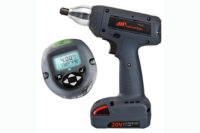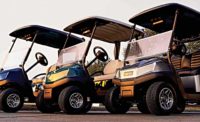Assemblers in many different industries depend on all sorts of pneumatic, DC electric and battery powered tools for a wide variety of fastening applications. Unfortunately, the devices are also the source of countless ergonomic headaches for manufacturing engineers.
With repeated use, handles, triggers, torque reaction, vibration, noise and weight all present potential trouble spots. That’s especially true in the automotive industry.
If a vehicle contains 250 threaded fasteners and an assembly line is turning out several hundred thousand vehicles annually, that’s more than 100 million run-downs. Without the right power tools and accessories, that kind of volume can result in an ergonomic nightmare.
“Fastening tools can potentially cause a lot of ergonomic problems, because an operator performing [repetitive motions to keep up with line rates] is interacting with tools a lot,” says Bob Fox, Ph.D., technical fellow for ergonomics at General Motors Co. “Tools are in their hands driving multiple fasteners every hour.
“There are some inherent issues with power tools, due to torque reaction and vibration, in addition to the weight of the tool and the operator’s posture,” adds Fox. “All of that can contribute to an injury or illness. By applying ergonomic principles, we try to eliminate the risk or greatly reduce the risk.”
According to Fox, the current generation of fastening tools is much more ergonomic than what was available 10 to 20 years ago. “We’ve seen a lot of improvement in tools,” he points out. “Today, there’s less torque reaction, less vibration, and better design of handles and other features.
“But, how ergonomic a tool is depends upon its design features, as well as the uses it’s put to,” warns Fox. “You can still have ergonomic risk factors with an otherwise ‘ergonomic’ tool.”
“A tool becomes ‘ergonomic’ only when it fits the task [an assembler] is performing, and when it fits the hand without causing awkward postures, harmful contact pressures, or other safety and health risks,” adds Cindy Roth, CEO of Ergonomic Technologies Corp. “If a tool is being used in a way it was not intended, it might contribute to an injury, such as carpal tunnel syndrome, tendonitis or muscle strain.
“The crucial ergonomic principle in tool use and design is ‘bend thetool, not the wrist,’” Roth points out. “However, [that] does not always prevent discomfort and injuries when tool handles that are bent are used incorrectly, regardless of the layout of the work situation.”
New Designs
Power tool suppliers have made tremendous strides in ergonomics in the past decade. Many advances have been due to new designs that address weight, shape and other factors, such as how a tool performs an assembly task and interacts with an operator.
“Advances in computer-aided design and manufacturing allow for more complex designs to improve elements, such as ergonomic grips, that would not have been possible or cost-effective previously,” says Neil Maniccia, sales manager at ASG Precision Fastening, a division of Jergens Inc. “Tool designs today are more likely to take ergonomic issues into consideration earlier in the design process than ever.”
“Features that reduce job complexity are the biggest contributor to more ergonomically friendly tools,” adds Tim McGuire, aerospace marketing director at Apex Tool Group LLC. “There has also been more time invested in design for manufacturability studies and process engineering work upfront.
“This includes finite element analysis and the use of 3D modeling to ensure that the best access for a tool is included in the design,” explains McGuire. “As a result, the operator isn’t straining to hold a tool in an awkward position.”
Materials used in fastening tools today are lighter, stronger and textured. They also have better thermal properties.
“More ergonomic features are being designed into the overall tool handle, such as no pinch point on the trigger,” explains Andrew Bardsley, global assembly leader at Ingersoll Rand. “The texture and thermal properties of the tool handle [now] prevent the hand getting too cold on air tools or too hot on electric tools.
“Advanced grip designs consider a range of hand sizes and the angle of the operation of the tool relative to the application,” Bardsley points out. “The grips are also now made from advanced materials and textures to stop the tool slipping out of a hand during use. This means the operator doesn’t have to grip the tool as hard, which also reduces stress in the hand and arm.”
Engineers at Panasonic researched hand sizes and shapes from around the world to design a comfortable ergonomic grip for their line of cordless assembly tools. “They focused on eliminating as much air as possible between the tool’s housing and the operator’s hand,” says Kevin Reiland, product manager at Panasonic Power Tools. “With this new design, the operator doesn’t need to grip the tool as tightly, reducing operator fatigue.”
The engineers also turned to lighter, stronger materials. For instance, magnesium is used for housings instead of aluminum. “The design of the housings have also been lightened up through advanced CAD designs, allowing the use of the least amount of material, while maintaining the strength of the tool,” notes Reiland.
Other tool suppliers are using polymers and composites to make their products lighter and to isolate vibration. “In addition, we use tungsten in some of our percussive tools to increase power and create much more powerful tools in a very small package,” says Thomas Honsa, president and CEO of Honsa Ergonomic Technologies Inc. “This really improves ergonomics for operators.”
In addition to the weight of tools and how easily they can be handled, suppliers are focusing on tool speed and cycle times to reduce excessive heat buildup. “We are looking at heat generation of the electric motor and how to keep tools cool for operator touch,” says Paul Gomez, director of engineering at FEC Automation Systems. “This is usually achieved with insulating sleeves.”
Battery-Powered Problems
More and more manufacturers are turning to cordless tools, because they offer greater maneuverability in tight spaces, such as automotive interiors and aircraft cockpits. The tools are ergonomic because they eliminate being tethered by a cable or an air hose. That frees the operator to move with the tool and get in the most comfortable position to accomplish a job fast, securely and efficiently.
Assemblers can freely move with the tool to the tightening application’s location, rather than being restricted to the limits and the moving of the air hose or cable. In most cases, cordless tools also run more quietly than air tools. However, battery-powered tools have traditionally been plagued by weight problems.
“The energy density of the battery is one challenge,” says Brody Wang, aerospace manufacturing technologies engineer at Apex Tool. “But, batteries are getting better. We are also keeping an eye on promising technologies like supercapacitors. The primary driver is weight related to size, power and battery life.”
“The challenges of battery tools include the power-to-weight ratio from an ergonomic perspective,” adds Dave Garner, key customer manager for automation tools at Desoutter Industrial Tools. “We addressed the power-to-weight ratio and the speed of the tool by using lighter materials and compact design of components such as PCB boards, motors, gearboxes and right-angle heads. On our nutrunners, the motor has been designed to optimize its size without compromising the speed of the tool.”
“When compared to pneumatic tool platforms, battery tools were traditionally at a disadvantage, due to the need to have the energy source on board the physical product,” notes Steve Tayler, vice president of national industrial sales at Makita USA Inc. “The battery itself was a significant percentage of the total tool weight and, at times, presented an ergonomically unfriendly option for manufacturers wanting to shift away from expensive, tethered operations.”
During the past few years, tool suppliers have developed advanced battery and motor technologies to create more ergonomic products. For instance, batteries in cordless tools have transitioned to lithium-ion based material to boost energy output while reducing weight.
“Older nickel-cadmium platforms were heavy, as well as environmentally toxic,” notes Tayler. “Today’s lithium-ion batteries offer significantly improved energy efficiencies at a fraction of the weight.”
Electric motor technologies continue to advance along similar lines.
Brushless motors were first introduced in cordless tools a decade ago. That allows more functional applications without dramatically increasing the physical size of the tool.
“Brushless [technology] almost doubles the energy utilization efficiencies within the motor when compared to brushed designs,” claims Tayler. “A more efficient motor combined with more efficiently applied, and longer-lasting, energy provides the foundation for real ergonomic advancement, as higher performance is achieved without the bulk.”
To reduce the total time exposure of an operator to the stress of absorbing the torque reaction of a direct-drive tool, it must be capable of achieving high speeds. Unfortunately, high motor speed and vastly divergent speeds eat up a lot of battery power.
“Battery power and battery weight are directly related,” notes Hans Reiter, sales manager for tightening systems at Bosch Rexroth Corp. “The challenge is to find the right balance, where a comfortable battery size gives you the best power source for your tightening operations.
“We [have invested] significant engineering and testing efforts into optimizing power-to-weight performance to provide optimum ergonomics with precision tightening,” claims Reiter. “[Our] cordless clutch tools are now able to match the speed of what previously was achieved only by pneumatic clutch tools, but freeing the operator from an air hose and its associated obstruction.”
The ability to control the speed in every step of the run-down of a fastener allows the tool speed to slow down at the very end of the tightening cycle. This reduction in speed can turn an abrupt, jerky torque reaction into a smoother distribution of the torque reaction by spreading it over a longer period of time, thus resulting in a more ergonomic reaction.
“While this does not eliminate the torque reaction completely, it can manage it safely for operators of all types, including those of smaller stature or with less physical strength,” says Reiter. “At the same time, these tools achieve the torque accuracy level necessary for safety critical-operations.”











